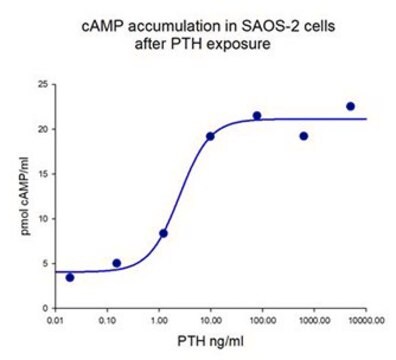SRP4651
PTHrP human
recombinant, expressed in E. coli, ≥98% (SDS-PAGE), ≥98% (HPLC)
Sinónimos:
HHM, PLP, PTHLH, PTHR, PTHRP
Iniciar sesiónpara Ver la Fijación de precios por contrato y de la organización
About This Item
Productos recomendados
biological source
human
recombinant
expressed in E. coli
assay
≥98% (HPLC)
≥98% (SDS-PAGE)
form
lyophilized
mol wt
~9.8 kDa
packaging
pkg of 50 μg
storage condition
avoid repeated freeze/thaw cycles
impurities
endotoxin, tested
NCBI accession no.
shipped in
wet ice
storage temp.
−20°C
Gene Information
human ... PTHLH(5744)
General description
Parathyroid Hormone-like related Protein (PTHrP) is a member of the Parathyroid hormone family that is expressed in the mammary gland. It is known as a potent inhibitor of chondrocyte maturation. PTHrP is expressed by periarticular perichondrial cells and exerts its biological activity on PP-R expressing cells. During endochondral bone development PTHrP plays a major role in suppressing the onset of hypertrophic differentiation. It is also responsible for most cases of humoral hypercalcemia of malignancy. Recombinant Human PTHrP is a 9.8 kDa protein consisting of 86 amino acid residues.
Recombinant Human PTHrP is a 9.8 kDa protein consisting of 86 amino acid residues.
Application
The human parathyroid hormone-like related protein (PTHrP) has been used as an osteoarthritis-associated factor regulating hypertrophic differentiation of human chondrocytes. It has also been used in the regulation of the expression of Smpd3 (Sphingomyelin phosphodiesterase 3) in chondrocytes.
Biochem/physiol Actions
The gene PTHrP (parathyroid hormone-like related protein) encodes a protein involved in skeletal development. It binds to the receptor activated by PTH (parathyroid hormone) and functions in smooth muscle relaxation, regulation of cellular proliferation and differentiation. It also regulates endochondral bone development and proliferation of growth plate chondrocytes. It regulates fetal blood calcium and placental calcium transport. It has been associated with malignant hypercalcemia. Mutation in this gene has been associated with brachydactyly type E2 (BDE2).
Physical form
Sterile filtered and lyophilized without additives.
Reconstitution
Centrifuge the vial prior to opening. Avoid freeze-thaw cycles.
Reconstitute in water to a concentration of 0.1-1.0 mg/mL. This solution can then be diluted into other aqueous buffers.
Storage Class
10 - Combustible liquids
wgk_germany
WGK 3
Elija entre una de las versiones más recientes:
Certificados de análisis (COA)
Lot/Batch Number
¿No ve la versión correcta?
Si necesita una versión concreta, puede buscar un certificado específico por el número de lote.
¿Ya tiene este producto?
Encuentre la documentación para los productos que ha comprado recientemente en la Biblioteca de documentos.
Smpd3 Expression in both Chondrocytes and Osteoblasts Is Required for Normal Endochondral Bone Development.
Li J
Molecular and Cellular Biology, 36, 2282-2299 (2016)
Jeroen C H Leijten et al.
Arthritis research & therapy, 15(5), R126-R126 (2013-11-30)
Osteoarthritis is, at least in a subset of patients, associated with hypertrophic differentiation of articular chondrocytes. Recently, we identified the bone morphogenetic protein (BMP) and wingless-type MMTV integration site (WNT) signaling antagonists Gremlin 1 (GREM1), frizzled-related protein (FRZB) and dickkopf
Exome sequencing reveals a novel PTHLH mutation in a Chinese pedigree with brachydactyly type E and short stature.
Wang J
Clinica Chimica Acta; International Journal of Clinical Chemistry, 446:9-44614 (2015)
Huiren Tao et al.
PloS one, 6(8), e23199-e23199 (2011-09-03)
p38 mitogen-activated protein kinase (MAPK) acts downstream in the signaling pathway that includes receptor activator of NF-κB (RANK), a powerful inducer of osteoclast formation and activation. We investigated the role of p38 MAPK in parathyroid hormone related protein (PTHrP)-induced osteoclastogenesis
PTHrP and skeletal development.
Kronenberg HM
Annals of the New York Academy of Sciences, 1068, 1-13 (2006)
Nuestro equipo de científicos tiene experiencia en todas las áreas de investigación: Ciencias de la vida, Ciencia de los materiales, Síntesis química, Cromatografía, Analítica y muchas otras.
Póngase en contacto con el Servicio técnico



